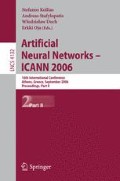Abstract
An engineering control approach to attention is developed here, based on the original CODAM (COrollary Discharge of Attention Movement) model. Support for the existence in the brain of the various modules thereby introduced is presented, especially those components involving an observer. The manner in which the model can be extended to executive functions involving the prefrontal cortices is then outlined, Finally the manner in which conscious experience may be supported by the architecture is described.
Access this chapter
Tax calculation will be finalised at checkout
Purchases are for personal use only
Preview
Unable to display preview. Download preview PDF.
References
Taylor, J.G.: Attentional Movement: the control basis for Consciousness. Soc. Neurosci. Abstr. 26, 2231, 839.3 (2000)
Taylor, J.G.: Paying Attention to Consciousness. Progress in Neurobiology 71, 305–335 (2003)
Fragopanagos, N., Kockelkoren, S., Taylor, J.G.: Modelling the Attentional Blink Cogn Brain Research (2005) (in press)
Taylor, J.G.: Race for Consciousness. MIT Press, Cambridge (1999)
Sergent, C., Baillet, S., Dehaene, S.: Timing of the brain events underlying access to consciousness during the attentional blink. Nat Neurosci. (September 2005)
Phillips, C.L., Harbour, R.D.: Feedback Control Systems. Prentice Hall, New Jersey (2000)
Desimone, Duncan: Neural mechanisms of selective visual attention. Ann. Rev. Neurosci. 18, 193–222 (1995)
Taylor, J.G.: From Matter to Consciousness: Towards a Final Solution? Physics of Life Reviews 2, 1–44 (2005)
Taylor, J.G., Fragopanagos, N.: The interaction of attention and emotion. Neural Networks 18(4) (2005) (in press)
Barto, A.: Adaptive Critics and the basal ganglia. In: Houk, J.C., Davis, J., Beiser, D.C. (eds.) Models of Information Processing n the Basal Ganglia. MIT Press, Cambridge (1995)
Houde, O., Tzourio-Mazayer, N.: Neural foundations of logical and mathematical cognition. Nat. Rev. Neuroscience 4, 507–514 (2003)
Kasderidis, S., Taylor, J. G.: Attentional Agents and Robot Control. International Journal of Knowledge-based & Intelligent Systems 8, 69–89 (2004)
Kasderidis, S., Taylor, J.G.: Combining Attention and Value Maps. In: Duch, W., Kacprzyk, J., Oja, E., Zadrożny, S. (eds.) ICANN 2005. LNCS, vol. 3696, pp. 79–84. Springer, Heidelberg (2005)
Taylor, N., Taylor, J.G.: Analysis of Recurrent Cortico-Basal-Ganglia-Thalamic Loops for Working Memory. Biological Cybernetics 82, 415–432 (2000)
Monchi, O., Taylor, J.G., Dagher, A.: A neural model of working memory processes in normal subjects, Parkinson’s disease and schizophrenia for fMRI design and predictions. Neural Networks 13(8-9), 963–973 (2000)
Monchi, O., Petrides, M., Doyon, J., Postuma, R.B., Worsley, K., Dagher, A.: Neural Bases of Set Shifting Deficits in Parkinson’s Disease. Journal of Neuroscience 24, 702–710 (2004)
Baddeley, A.: Working Memory. Oxford University Press, Oxford (1986)
Lepstein, J., Griffin, I.C., Devlin, J.T., Nobre, A.C.: Directing spatial attention in mental representations: Interactions between attention orienting and working-memory load. NeuroImage 26, 733–743 (2005)
Yoon, J.H., Curtis, C.E., D’Esposito, M.D.: Differential effects if distraction during working memory on delay-period activity in the prefrontal cortex and the visual association cortex. NeuroImage 29, 1117–1126 (2006)
Xu, Y., Chun, M.M.: Dissociable neural mechanisms supporting visual shot-term memory for objects. Nature 440, 91–95 (2006)
Author information
Authors and Affiliations
Editor information
Editors and Affiliations
Rights and permissions
Copyright information
© 2006 Springer-Verlag Berlin Heidelberg
About this paper
Cite this paper
Taylor, J.G. (2006). Towards a Control Theory of Attention. In: Kollias, S., Stafylopatis, A., Duch, W., Oja, E. (eds) Artificial Neural Networks – ICANN 2006. ICANN 2006. Lecture Notes in Computer Science, vol 4132. Springer, Berlin, Heidelberg. https://doi.org/10.1007/11840930_48
Download citation
DOI: https://doi.org/10.1007/11840930_48
Publisher Name: Springer, Berlin, Heidelberg
Print ISBN: 978-3-540-38871-5
Online ISBN: 978-3-540-38873-9
eBook Packages: Computer ScienceComputer Science (R0)

